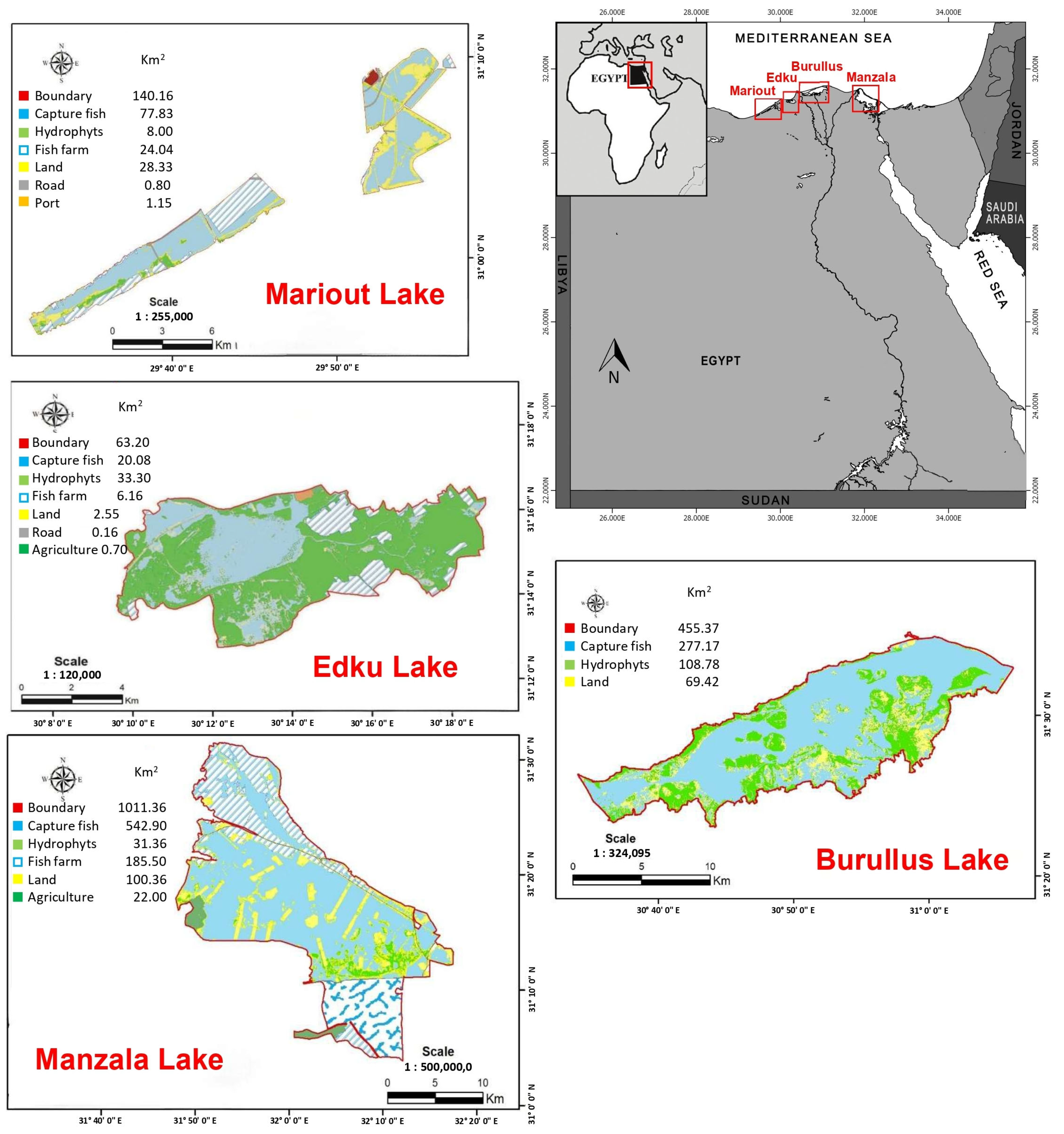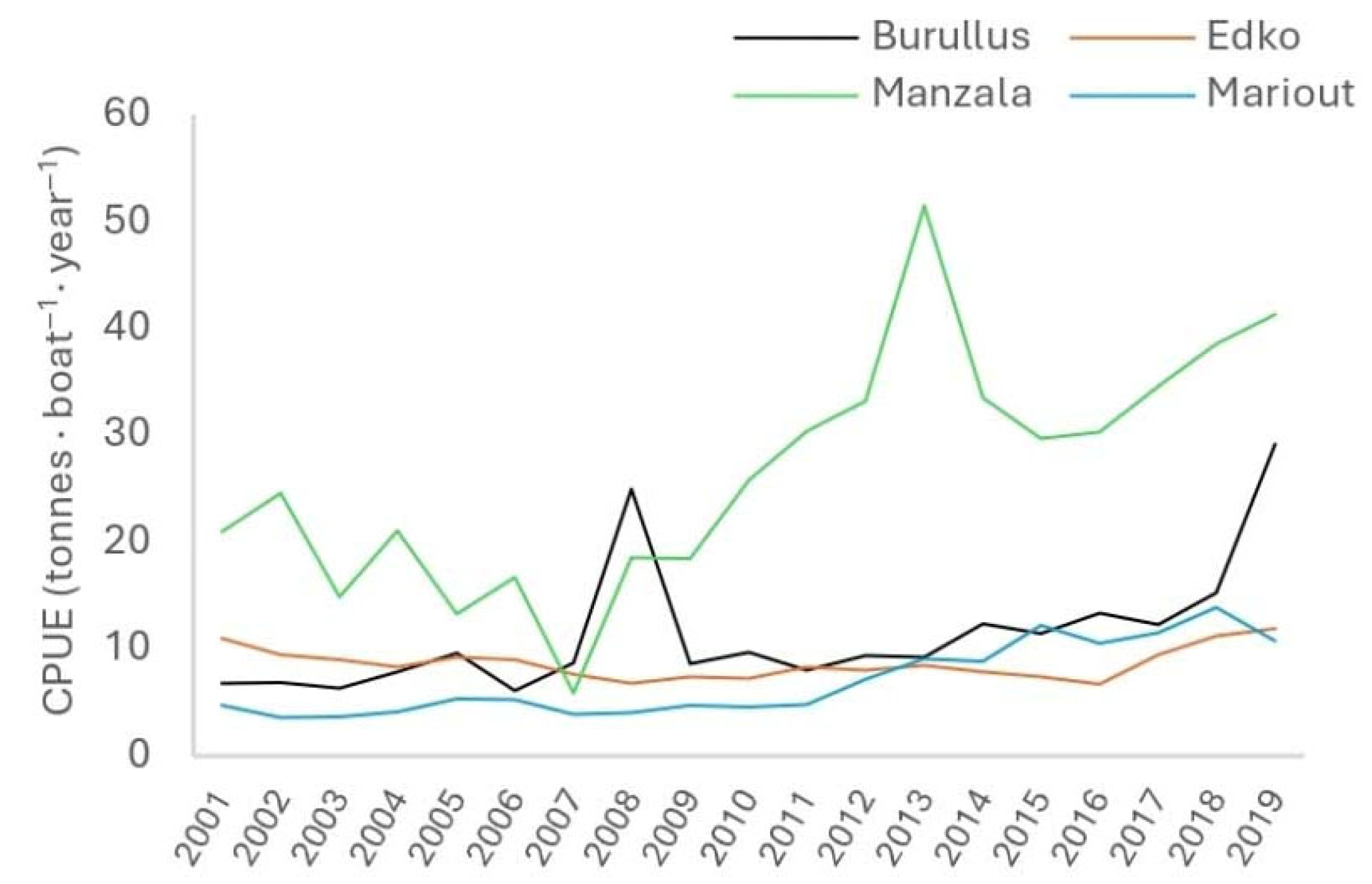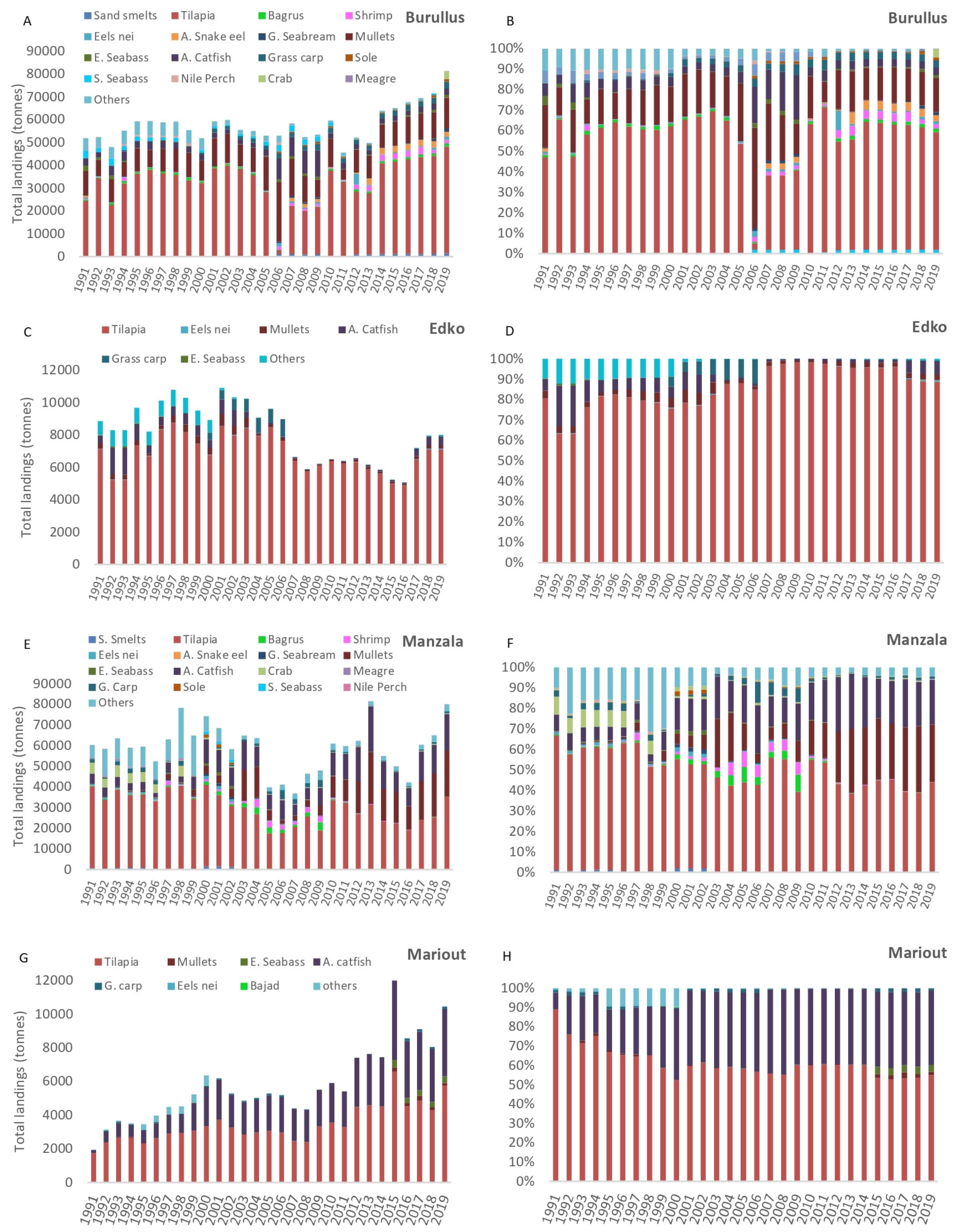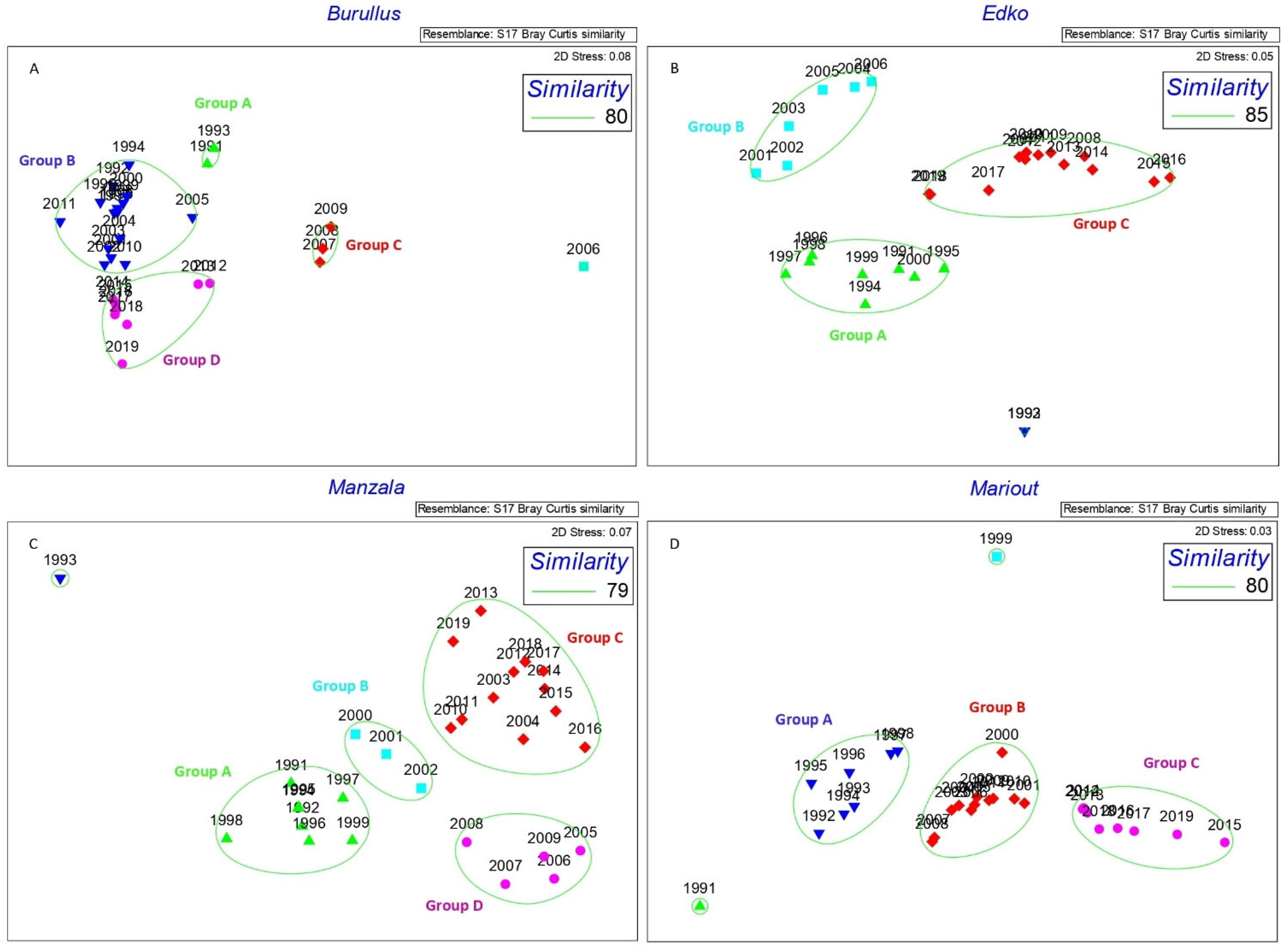Long-Term Changes in Fish Landings and Fish Community Structure in Nile Delta Lakes: Implications for Fisheries Sustainability
Abstract
1. Introduction
2. Material and Methods
2.1. Study Area
2.2. Data Collection and Analysis
3. Results
3.1. Annual Changes in Landings, Fishing Effort, and CPUE
3.2. Annual Changes in Fish Community Structure
4. Discussion
5. Conclusions
Author Contributions
Funding
Institutional Review Board Statement
Data Availability Statement
Conflicts of Interest
References
- Azevedo-Santos, V.M.; Marques, L.M.; Teixeira, C.R.; Giarrizzo, T.; Barreto, R.; Rodrigues-Filho, J.L. Digital media reveal negative impacts of ghost nets on Brazilian marine biodiversity. Mar. Pollut. Bull. 2021, 172, 112821. [Google Scholar] [CrossRef]
- Ruppert, J.L.; Vigliola, L.; Kulbicki, M.; Labrosse, P.; Fortin, M.J.; Meekan, M.G. Human activities as a driver of spatial variation in the trophic structure of fish communities on Pacific coral reefs. Glob. Change Biol. 2018, 24, 67–79. [Google Scholar] [CrossRef] [PubMed]
- Sciutteri, V.; Pedà, C.; Longo, F.; Calogero, R.; Cangemi, G.; Pagano, L.; Battaglia, P.; Nannini, M.; Romeo, T.; Consoli, P. Integrated approach for marine litter pollution assessment in the southern Tyrrhenian Sea: Information from bottom-trawl fishing and plastic ingestion in deep-sea fish. Mar. Pollut. Bull. 2023, 188, 114661. [Google Scholar] [CrossRef]
- Worm, B.; Barbier, E.B.; Beaumont, N.; Duffy, J.E.; Folke, C.; Halpern, B.S.; Jackson, J.B.; Lotze, H.K.; Micheli, F.; Palumbi, S.R.; et al. Impacts of biodiversity loss on ocean ecosystem services. Science 2006, 314, 787–790. [Google Scholar] [CrossRef]
- Abdelhady, A.A.; Khalil, M.M.; Ismail, E.; Mohamed, R.S.; Ali, A.; Snousy, M.G.; Fan, J.; Zhang, S.; Yanhong, L.; Xiao, J. Potential biodiversity threats associated with metal pollution in the Nile–Delta ecosystem (Manzala lagoon, Egypt). Ecol. Indic. 2019, 98, 844–853. [Google Scholar] [CrossRef]
- Da Silva, J.R.M.C.; Bergami, E.; Gomes, V.; Corsi, I. Occurrence and distribution of legacy and emerging pollutants including plastic debris in Antarctica: Sources, distribution, and impact on marine biodiversity. Mar. Pollut. Bull. 2023, 186, 114353. [Google Scholar] [CrossRef]
- Geist, J.; Hawkins, S.J. Habitat recovery and restoration in aquatic ecosystems: Current progress and future challenges. Aquat. Conserv. Mar. Freshw. Ecosyst. 2016, 26, 942–962. [Google Scholar] [CrossRef]
- DiBattista, J.D.; Shalders, T.C.; Reader, S.; Hay, A.; Parkinson, K.; Williams, R.J.; Stuart-Smith, J.; McGrouther, M. A comprehensive analysis of all known fishes from Sydney harbour. Mar. Pollut. Bull. 2022, 185, 114239. [Google Scholar] [CrossRef]
- Smol, J.P. Under the radar: Long-term perspectives on ecological changes in lakes. Proc. R. Soc. B Biol. Sci. 2019, 286, 20190834. [Google Scholar] [CrossRef]
- Angeler, D.G.; Baho, D.L.; Allen, C.R.; Johnson, R.K. Linking degradation status with ecosystem vulnerability to environmental change. Oecologia 2015, 178, 899–913. [Google Scholar] [CrossRef]
- Galli, M.; Tepsich, P.; Baini, M.; Panti, C.; Rosso, M.; Vafeiadou, A.; Pantelidou, M.; Moulins, A.; Fossi, M.C. Microplastic abundance and biodiversity richness overlap: Identification of sensitive areas in the Western Ionian Sea. Mar. Pollut. Bull. 2022, 177, 113550. [Google Scholar] [CrossRef]
- Cheang, C.C.; Lee, B.Y.; Ip, B.H.Y.; Yiu, W.H.; Tsang, L.M.; Ang, P.O., Jr. Fish and crustacean biodiversity in an outer maritime estuary of the Pearl River Delta revealed by environmental DNA. Mar. Pollut. Bull. 2020, 161, 111707. [Google Scholar] [CrossRef] [PubMed]
- Greenstreet, S.P.; Rossberg, A.G.; Fox, C.J.; Le Quesne, W.J.; Blasdale, T.; Boulcott, P.; Moffat, C.F. Demersal fish biodiversity: Species-level indicators and trends based targets for the Marine Strategy Framework Directive. ICES J. Mar. Sci. 2012, 69, 1789–1801. [Google Scholar] [CrossRef][Green Version]
- Eme, D.; Rufino, M.M.; Trenkel, V.M.; Vermard, Y.; Laffargue, P.; Petitgas, P.; Pellissier, L.; Albouy, C. Contrasted spatio-temporal changes in the demersal fish assemblages and the dominance of the environment versus fishing pressure, in the Bay of Biscay and Celtic Sea. Progress Oceanogr. 2022, 204, 102788. [Google Scholar] [CrossRef]
- Vellend, M. Conceptual synthesis in community ecology. Q. Rev. Biol. 2010, 85, 183–206. [Google Scholar] [CrossRef]
- Dornelas, M.; Gotelli, N.J.; Shimadzu, H.; Moyes, F.; Magurran, A.E.; McGill, B.J. A balance of winners and losers in the Anthropocene. Ecol. Lett. 2019, 22, 847–854. [Google Scholar] [CrossRef]
- Broadway, K.J.; Pyron, M.; Gammon, J.R.; Murry, B.A. Shift in a large river fish assemblage: Body-size and trophic structure dynamics. PLoS ONE 2015, 10, e0124954. [Google Scholar] [CrossRef]
- Franco-Fuentes, E.; Moity, N.; Ramírez-Gonzalez, J.; Andrade-Vera, S.; Hardisson, A.; Rubio, C.; Paz, S.; González-Weller, D.; Gutiérrez, A.J. Analysis of metals and metalloid in commercial fish species from the Galapagos Marine Reserve: Toxicological and nutritional assessment. Mar. Pollut. Bull. 2023, 189, 114739. [Google Scholar] [CrossRef]
- Zhang, S.; Lu, Q.; Wang, Y.; Wang, X.; Zhao, J.; Yao, M. Assessment of fish communities using environmental DNA: Effect of spatial sampling design in lentic systems of different sizes. Mol. Ecol. Resour. 2020, 20, 242–255. [Google Scholar] [CrossRef]
- Food and Agriculture Organization of the United Nations. The State of World Fisheries and Aquaculture 2018: Meeting the Sustainable Development Goals; Food and Agriculture Organization of the United Nations (FAO): Rome, Italia, 2018; p. 227. [Google Scholar]
- Samy-Kamal, M. Status of fisheries in Egypt: Reflections on past trends and management challenges. Rev. Fish. Biol. Fish. 2015, 25, 631–649. [Google Scholar] [CrossRef]
- Samy-Kamal, M. Outlook on the fisheries policy reform in Egypt and the draft of the new fisheries law. Mar. Policy 2020, 120, 104136. [Google Scholar] [CrossRef]
- Abdelhady, A.A.; Samy-Kamal, M.; Abdel-Raheem, K.H.; Ahmed, M.S.; Khalil, M.M. Historical changes in fish landings indicate a significant shift in fish catch composition and biodiversity loss in the Nile-Delta lakes. Mar. Pollut. Bull. 2023, 194, 115368. [Google Scholar] [CrossRef] [PubMed]
- Samy-Kamal, M.; Mehanna, S.F. Evolution of fishing effort and fishing capacity during the last two decades (2000–2019) in Egypt’s marine fisheries: Spotting the fleet overcapacity. Reg. Environ. Chang. 2023, 23, 113. [Google Scholar] [CrossRef]
- Osman, Y.A.; Samy-Kamal, M. Diversity and characteristics of commercial Red Sea Fish species based on fish market survey: Informing management to reduce the risk of overfishing. J. Fish. Biol. 2023, 102, 936–951. [Google Scholar] [CrossRef]
- Clarke, K.R.; Gorley, R.N. PRIMER V6: User Manual/Tutorial; PRIMER-E: Plymouth, UK, 2006. [Google Scholar]
- Clarke, K.R.; Warwick, R.M. Change in Marine Communities: An Approach to Statistical Analysis and Interpretation, 2nd ed.; PRIMER-E: Plymouth, UK, 2001. [Google Scholar]
- Bray, J.R.; Curtis, J.T. An ordination of the upland forest communities of southern Wisconsin. Ecol. Monogr. 1957, 27, 326–349. [Google Scholar] [CrossRef]
- Mehanna, S.F.; Faragallah, A.M.; Fattouh, S.A.; Haggag, S.M.; Clip, Z.M. A comparative economic study before and during the current purification and development operations in Lake Burullus. Egypt. J. Aquat. Biol. Fish. 2023, 27, 495–508. [Google Scholar] [CrossRef]
- Faragallah, A.M.; Fattouh, S.A.; EL-Karashily, A.F.; Haggag, S.M. The Impact of Rehabilitation Projects on the Taxonomic Composition and Economics of Fishing Activities in Burullus Wetland, Egypt. Egypt. J. Aquat. Biol. Fish. 2024, 28, 427. [Google Scholar] [CrossRef]
- Mehanna, S.F.; Hassan, N.H.; Koleib, Z.M.; El-Bokhty, E.A.E. Fish production, fishing gears, economic and social impacts of the purification and development project on Lake Manzalah fisheries, Egypt. Egypt. J. Aquat. Biol. Fish. 2023, 27, 85. [Google Scholar] [CrossRef]
- Hany, A.; Akl, F.; Hagras, M.; Balah, A. Assessment of recent rehabilitation projects’ impact on water quality improvement in Lake Burullus, Egypt. Ain Shams Eng. J. 2022, 13, 101492. [Google Scholar] [CrossRef]
- Shalloof, K.; El-Ganiny, A.; El-Far, A.; Fetouh, M.; Aly, W.; Amin, A. Catch composition and species diversity during dredging operations of Mediterranean coastal lagoon, Lake Manzala, Egypt. Egypt. J. Aquat. Res. 2023, 49, 347–352. [Google Scholar] [CrossRef]
- Ismail, A.; Hettiarachchi, H. Environmental damage caused by wastewater discharge into the Lake Manzala in Egypt. Am. J. Biosci. Bioeng. 2017, 5, 141–150. [Google Scholar] [CrossRef]
- El Kafrawy, S.B.; Bek, M.A.; Negm, A.M. An overview of the Egyptian northern coastal lakes. Egypt. Coast. Lakes Wetl. Part I Charact. Hydrodyn. 2018, 3–17. [Google Scholar]
- Samy-Kamal, M. Insights on illegal, unreported and unregulated (IUU) fishing activities by Egyptian vessels in neighbouring countries. Fishes 2022, 7, 288. [Google Scholar] [CrossRef]
- Moneer, A.; Agib, N.S.; Khedawy, M. An overview of the status of Lake Edku environment: Status, challenges, and next steps. Blue Econ. 2023, 1, 3. [Google Scholar] [CrossRef]
- El-Degwy, A.A.; Negm, N.A.; El-Tabl, A.S.; Goher, M.E. Assessment of heavy metal pollution in water and its effect on Nile tilapia (Oreochromis niloticus) in Mediterranean Lakes: A case study at Mariout Lake. Appl. Water Sci. 2023, 13, 50. [Google Scholar] [CrossRef]
- Elsira, I.; Tilley, A.; Samy-Kamal, M.; Aly, W. Digital transformation of Egyptian marine fisheries: A pathway to sustainable fisheries management. Mar. Policy 2025, 179, 106766. [Google Scholar] [CrossRef]






| Burullus | Group A | Group B | Group C | Group D | ||||||||
| Av. Similarity: 93.40 | Av. Similarity: 88.08 | Av. Similarity: 89.69 | Av. Similarity: 87.49 | |||||||||
| Species | Av. Bio. | Cont.% | Species | Av. Bio. | Cont. % | Species | Av. Bio. | Cont. % | Species | Av. Bio. | Cont. % | |
| Tilapia | 23,514,5 | 48.68 | Tilapia | 35,215,93 | 67.8 | Tilapia | 20,400,33 | 40.1 | Tilapia | 38,445,13 | 60.16 | |
| Mullets | 10,404 | 21.68 | Mullets | 9853,47 | 16.76 | Mullets | 11,855 | 18.36 | Mullets | 10,969,88 | 18.1 | |
| Others | 5388,5 | 11.03 | Others | 3900 | 5.58 | A. catfish | 10,008,33 | 18.28 | ||||
| A. catfish | 3734 | 6.74 | ||||||||||
| S. Seabass | 2914 | 6.1 | ||||||||||
| Edko | Group A | Group B | Group C | |||||||||
| Av. Similarity: 92.22 | Av. Similarity: 92.18 | Av. Similarity: 91.64 | ||||||||||
| Species | Av. Bio. | Cont.% | Species | Av. Bio. | Cont. % | Species | Av. Bio. | Cont. % | ||||
| Tilapia | 7586,38 | 81.09 | Tilapia | 8166,17 | 87.54 | Tilapia | 8166,17 | 87.54 | ||||
| Others | 897,75 | 9.69 | G. carp | 817,33 | 7.84 | G. carp | 817,33 | 7.84 | ||||
| Manzala | Group A | Group B | Group C | Group D | ||||||||
| Av. Similarity: 85.14 | Av. Similarity: 90.93 | Av. Similarity: 84.70 | Av. Similarity: 83.99 | |||||||||
| Species | Av. Bio. | Cont.% | Species | Av. Bio. | Cont. % | Species | Av. Bio. | Cont. % | Species | Av. Bio. | Cont. % | |
| Tilapia | 36,309,38 | 65.55 | Tilapia | 34,681 | 51.49 | Tilapia | 27,500,67 | 46.62 | Tilapia | 19,965 | 50.71 | |
| Others | 12,559,5 | 17.05 | A. catfish | 10,429 | 15.65 | Mullets | 16,249,75 | 25.61 | A. catfish | 7329,2 | 17.4 | |
| A. catfish | 4164,25 | 6.46 | Others | 6200,33 | 9.13 | A. catfish | 13,583 | 21.67 | Mullets | 3387,2 | 6.91 | |
| Mullets | 3996 | 6.33 | Others | 3011,8 | 6.49 | |||||||
| Shrimp | 2478,8 | 6.03 | ||||||||||
| G. carp | 2614 | 5.23 | ||||||||||
| Mariout | Group A | Group B | Group C | |||||||||
| Av. Similarity: 89.94 | Av. Similarity: 92.16 | Av. Similarity: 89.33 | ||||||||||
| Species | Av. Bio. | Cont.% | Species | Av. Bio. | Cont. % | Species | Av. Bio. | Cont. % | ||||
| Tilapia | 2635,86 | 72.74 | Tilapia | 3099,08 | 58.34 | Tilapia | 4953,88 | 57.75 | ||||
| A. catfish | 865,43 | 21.7 | A. catfish | 2102,75 | 40.85 | A. catfish | 3449,38 | 39.19 | ||||
Disclaimer/Publisher’s Note: The statements, opinions and data contained in all publications are solely those of the individual author(s) and contributor(s) and not of MDPI and/or the editor(s). MDPI and/or the editor(s) disclaim responsibility for any injury to people or property resulting from any ideas, methods, instructions or products referred to in the content. |
© 2025 by the authors. Licensee MDPI, Basel, Switzerland. This article is an open access article distributed under the terms and conditions of the Creative Commons Attribution (CC BY) license (https://creativecommons.org/licenses/by/4.0/).
Share and Cite
Samy-Kamal, M.; Abdelhady, A.A. Long-Term Changes in Fish Landings and Fish Community Structure in Nile Delta Lakes: Implications for Fisheries Sustainability. Fishes 2025, 10, 404. https://doi.org/10.3390/fishes10080404
Samy-Kamal M, Abdelhady AA. Long-Term Changes in Fish Landings and Fish Community Structure in Nile Delta Lakes: Implications for Fisheries Sustainability. Fishes. 2025; 10(8):404. https://doi.org/10.3390/fishes10080404
Chicago/Turabian StyleSamy-Kamal, Mohamed, and Ahmed A. Abdelhady. 2025. "Long-Term Changes in Fish Landings and Fish Community Structure in Nile Delta Lakes: Implications for Fisheries Sustainability" Fishes 10, no. 8: 404. https://doi.org/10.3390/fishes10080404
APA StyleSamy-Kamal, M., & Abdelhady, A. A. (2025). Long-Term Changes in Fish Landings and Fish Community Structure in Nile Delta Lakes: Implications for Fisheries Sustainability. Fishes, 10(8), 404. https://doi.org/10.3390/fishes10080404







